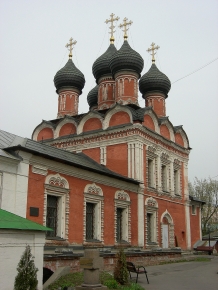Vysokopetrovsky Monastery
The first mention of a monastery in chronicles dates to 1377. However, a male monastery was supposedly founded earlier, in 1315, by Metropolitan of Kiev and All Rus Peter. A cathedral built by Italian architect Aleviz Fryazin in 1514 was dedicated to Metropolitan Peter who had been consecrated a saint after his death.
In the end of the 17th century, the territory occupied by the monastery was considerably expanded by adding a portion of the estate owned by the Naryshkins, relatives of Tsarina Natalia Kirillovna, mother of Peter I. The courtyard of the Naryshkins estate was adjacent to the southern fence of the monastery and therefore it stayed in the good graces of the royal family. The Naryshkins mansion became part of the Brethren’s Cells, and the estate’s gate in Krapivensky Lane dated from the 16th century became the rear gate of the Monastery.
The Monastery achieved its heyday under the reign of Peter I. The construction of stone buildings began in the mid-1680s, when the foundation of a church dedicated to the Bogolyubskaya Icon of the Mother of God was laid. The church then became the family vault of the Naryshkins. The stone five-dome church has the tombs of Tsarina Natalia Kirillovna’s brothers Ivan and Afanasiy who were murdered by the rebellious Streltsy (shooters) in 1682. At the end of the 19th century, the church’s refectory had 18 tombs of the Naryshkin family members (9 men and 9 women).
In the 1690s, the cathedral of Metropolitan Peter was reconstructed into a pillar-shaped temple with an eight-petal layout. About the same time, the former Naryshkins’ mansion was extended and provided with the second floor for the Brethren’s Cells.
The Church of Sergius of Radonezh with a refectory was built in 1690–1694 to commemorate the salvation of Peter I who was hiding himself from the conspirators in the Trinity Monastery of St. Sergius (elevated to the status of lavra in 1742). Originally single-domed, the church became five-domed as early as 1704–1706. The bell tower with the gate church dedicated to the Intercession of the Theotokos was completed in 1694 and still remains a high-rise landmark in Petrovka Street.
The Vysokopetrovsky Monastery was among the monasteries most revered and frequently visited by the royal family. On May 5, 1690, Tsars Ivan Alekseevich and Peter Alekseevich attended the consecration of the reconstructed Church of St. Peter the Metropolitan. On May 1, 1691, Peter I “was pleased” to visit the monastery on the occasion of the funeral of his grandfather Kirill Naryshkin.
In the 1740s, the monastery’s ensemble of structures was expanded to include the Church of the Tolga Icon of the Mother of God (Peter’s escape to the Trinity Monastery of St. Sergius coincided with the feast of the icon). In the 1750s, the Church of St. Pachomius the Great was built above the rear gate. Originally, it was not associated with Peter’s program of temple dedications, but the church was re-consecrated in the name of the Holy Apostles Peter and Paul not long before the 1917 revolution.
In 1918, the monastery was discontinued but its churches continued to operate. In 1929, the monastery’s structures were given to house civil institutions and residential premises. In 2009, it was decided to revive the Monastery. Archaeological survey on the grounds and restoration of the main structures of the Monastery, which is a monument of federal significance, began in the 1980s and gained even more momentum after 2015 which was considered by the Church as the year of its 700th anniversary.


